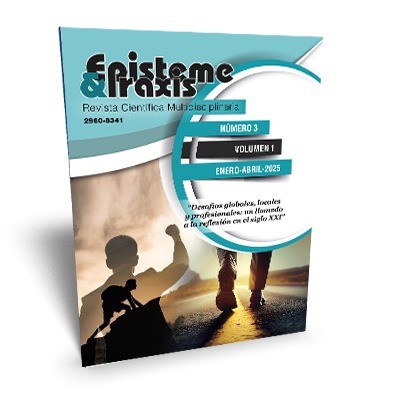Biological effectiveness of Nicosave on Spodoptera frugiperda J. E. Smith in corn crop Zea mays L
DOI:
https://doi.org/10.62451/rep.v3i1.74Keywords:
Spodoptera frugiperda, Zea mays, larvaAbstract
The research was carried out at the El Aeropuerto Farm located in the cartographic quadrant 48-126-092 Caunao road, belonging to the Manuel Ascunce Credit and Services Cooperative, Cienfuegos municipality in one hectare planted with corn, variety, TGH on a Brown soil with Carbonate, in the period from March to August, year 2022, rainy season, with the objective of evaluating the effectiveness of the product (Nicosave) on Spodoptera frugiperda J. E. Smith in the cultivation of Zea mays corn. A completely randomized design was carried out for the in vitro evaluation and a randomized block for the field area, where for the first case, the concentration of 75 'percent demonstrated the best results and for the application of the product in the field at the dose of 19 L/ha showed the best effectiveness after three days with 63 percent. Recommending to the integrated pest management commission of the Cienfuegos province that the application of the alternative insecticide Nicosave for Spodoptera frugiperda in the first and second instar of the larva be included in the corn cultivation strategy.
References
Aldana Llanos, L., Salinas-Sánchez, D. O., Valdés-Estrada, E., Gutiérrez-Ochoa, M., Rodríguez Flores, E., & Navarro-García, V. (2012). Biological activity of dose extracts of Tagetes erecta L. on Spodoptera frugiperda (J. E. Smith). Southwestern DOI: https://doi.org/10.3958/059.037.0104
Entomologist, 37(1), 31-38. https://bioone.org/journals/southwestern-entomologist/volume-37/issue-1/059.037.0104/Biological-Activity-of-Dose-Extracts-of-Tagetes-erecta-L-on/10.3958/059.037.0104.short?tab=ArticleLinkCited
Espinosa, G. (2020). Evaluación de tres bioinsecticidas para el control del gusano cogollero del maíz (Spodoptera frugiperda) en condiciones de laboratorio . (Tesis de pregrado). Universidad Técnica Estatal de Quevedo.
Acuña Jiménez, M., García Gutiérrez, C., Rosas García, N. M., López Meyer, M., & Saínz Hernández, J. C. 2015). Formulación de Metarhizium anisopliae (Metschnikoff) Sorokin con polímeros biodegradables y su virulencia contra Heliothis virescens (Fabricius). Revista internacional de contaminación ambiental, 31(3), 219-226. http://www.scielo.org.mx/scielo.php?script=sci_arttext&pid=S0188-49992015000300001&lng=es&tlng=es
González Vázquez, R. E., Castellón Valdés, M. del C., & Grillo Ravelo, H. (2020). La tabaquina, una alternativa para el manejo de Tarophagus colocasiae Matzumura (Auchenorhyncha: Delphacidae). Revista De Protección Vegetal, 34(3). https://revistas.censa.edu.cu/index.php/RPV/article/view/1050
Guevara Álvarez, Y. (2020). Control biológico del cogollero (Spodoptera frugiperda) en el cultivo de maíz (Zea mays L.), en la comunidad de Santiago, Aymaraes–2018. (Tesis de licenciatura). Universidad Tecnológica de Los Andes.
Guevara Martinez, G. M. (2019). Ficha Técnica Gusano cogollero Spodoptera frugiperda (J.E. Smith) (Lepidoptera: Noctuidae). Centro Nacional de Referencia Fitosanitaria. https://www.gob.mx/cms/uploads/attachment/file/635234/Gusano_cogollero_en_ma_z_y_arroz.pdf
Isman, M. (2006). Botanical insecticides, deterrents, and repellents in modern agriculture and increasingly regulated world. Annu. Rev. Entomol., 51, 45-66. https://pubmed.ncbi.nlm.nih.gov/16332203/ DOI: https://doi.org/10.1146/annurev.ento.51.110104.151146
Ordóñez-García, M., Rios-Velasco, C., Berlanga-Reyes, D. I., Acosta-Muñiz, C. H., Salas-Marina, M. Á., & Cambero-Campos, O. J. (2015). Occurrence of natural enemies of Spodoptera frugiperda (Lepidoptera: Noctuidae) in Chihuahua, Mexico. The Florida Entomologist, 98(3), 843–847. http://www.jstor.org/stable/24587732 DOI: https://doi.org/10.1653/024.098.0305
Papucci, S. P., González, A., & Cruciani, M. (2022). Efecto del daño foliar y el ambiente sobre el rendimiento en el cultivo de maiz. Ciencias Agronómicas, (34). https://doi.org/10.35305/agro34.225 DOI: https://doi.org/10.35305/agro34.225
Regnault-Roger, C., Philogène, B., & Vincent, C. (2004). Biopesticidas de origen vegetal. Mundi-Prensa.
Rivas Cano, A., & Rodríguez Chalarca, J. (2020). Descripción de los estados de desarrollo de Dalbulus maidis (DeLong)(Hemiptera: Cicadellidae) Vector de enfermedades en maíz. CIAT Publication. Alianza de Bioversity International y el Centro Internacional de Agricultura Tropical (CIAT). https://cgspace.cgiar.org/server/api/core/bitstreams/6ca587c3-680c-414a-9152-30a7fe7c72df/content
Ruiz Hernández, E. I. (2001). Determinación de la actividad insecticida de extractos de plantas en spodoptera frugiperda lepidoptera: noctuidae. (Tesis doctoral). Universidad Nacional Autónoma de Nicaragua.
Silva, G., Lagunes, A., & Rodríguez, J. (2003). Control de Sitophilus zeamais (Coleoptera: Curculionidae) con polvos vegetales solos y en mezcla con carbonato de calcio en maíz almacenado. Ciencias Investigación Agraria, 30(3), 153-160. DOI: https://doi.org/10.7764/rcia.v30i3.271
Sotelo, A., Valenzuela, R., Césare, M. F., Alegría, C., Norabuena, E., Gonzáles, T., Paitan, E., Valderrama, M. T., & Echevarría, M. (2020). Determinación de la digestibilidad y energía digestible del forraje seco de mucuna (Mucuna pruriens) en cuyes. Revista de Investigaciones Veterinarias del Perú, 31(1). http://www.scielo.org.pe/scielo.php?script=sci_arttext&pid=S1609-91172020000100002&lng=es&nrm=iso&tlng=es DOI: https://doi.org/10.15381/rivep.v31i1.17537
Velázquez, T. N. (2018). Diagnóstico de la cadena de producción de maíz (Zea mays, Lin.) del Valle de San Andrés. (Tesis en opción al título de Ingeniero Agrónomo). Universidad de Pinar del Río.
Downloads
Published
How to Cite
Issue
Section
License
Copyright (c) 2025 Fernando Iglesias-Royero, Mariol Morejón-García, María Rosa Núñez-González, Pedro Luis Román-Olivera, Ernesto García-Quiñones

This work is licensed under a Creative Commons Attribution-NonCommercial-ShareAlike 4.0 International License.
Authors who publish in Episteme & Praxis agree to the following terms:
1. Copyright
Authors retain unrestricted copyright to their work. Authors grant the journal the right of first publication. To this end, they assign the journal non-exclusive exploitation rights (reproduction, distribution, public communication, and transformation). Authors may enter into additional agreements for the non-exclusive distribution of the version of the work published in the journal, provided that acknowledgment of its initial publication in this journal is given.
© The authors.
2. License
The articles are published in the journal under the Creative Commons Attribution-NonCommercial-ShareAlike 4.0 International License (CC BY-NC-SA 4.0). The terms can be found at: https://creativecommons.org/licenses/by-nc-sa/4.0/deed.en
This license allows:
- Sharing: Copying and redistributing the material in any medium or format.
- Adapting: Remixing, transforming, and building upon the material.
Under the following terms:
- Attribution: You must give appropriate credit, provide a link to the license, and indicate if any changes were made. You may do this in any reasonable manner, but not in any way that suggests the licensor endorses or sponsors your use.
- NonCommercial: You may not use the material for commercial purposes.
- ShareAlike: If you remix, transform, or build upon the material, you must distribute your creation under the same license as the original work.
There are no additional restrictions. You may not apply legal terms or technological measures that legally restrict others from doing anything the license permits.






